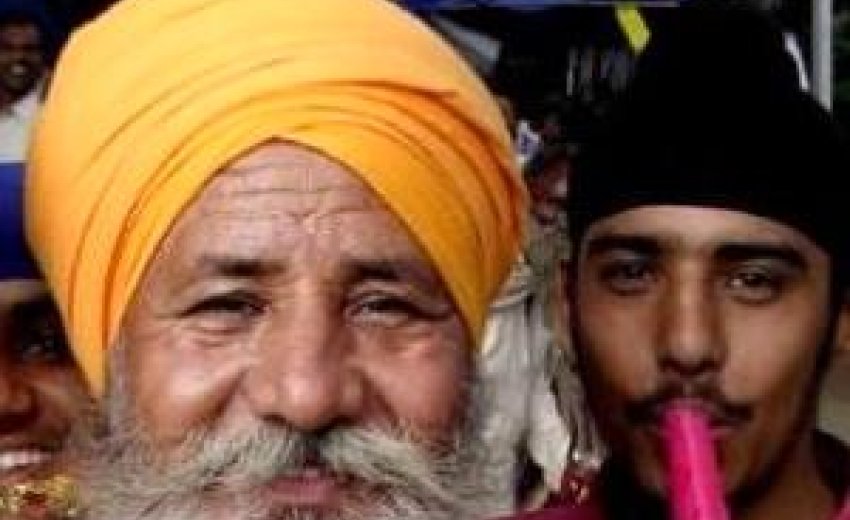 A dastaar in Punjabi and Hindi is a mandatory headgear for Sikhs. Dastaar is closely associated with Sikhism and is an important part of the Sikh culture. Wearing a turban is mandatory for all Amritdhari (baptized) Sikhs (also known as Khalsa).
A dastaar in Punjabi and Hindi is a mandatory headgear for Sikhs. Dastaar is closely associated with Sikhism and is an important part of the Sikh culture. Wearing a turban is mandatory for all Amritdhari (baptized) Sikhs (also known as Khalsa).
Among the Sikhs, the turban is an article of faith that represents honour, self-respect, courage, spirituality, and piety. The Khalsa Sikhs, who adorn the Five Ks, wear the turban partly to cover their long, uncut hair (kesh). The turban is mostly identified with the Sikh males, although some Sikh women also wear turban. The Khalsa Sikhs regard the turban as an important part of the unique Sikh identity. They are easily recognizable by their distinctive turbans. Some Sahajdhari Sikhs do not wear turbans.
History
The turban has been an important part of the Sikh culture since the time of the Sixth Guru. At Guru Ram Das Jyoti Jyot, his elder son Pirthi Chand wore a special turban, which is usually worn by an elder son when his father passes away. At that time Guru Arjan Dev was honoured with the turban of Guruship:
Marne di pag Pirthiye badhi.Guru Angad Dev honoured Guru Amar Das with a Siropa (turban) when he was made the Guru. Guru Gobind Singh, the last human Sikh Guru, wrote:
Guriyaee pag Arjan Ladhi
Kangha dono vakt kar, paag chune kar bandhai.
("Comb your hair twice a day and tie your turban carefully, turn by turn.")
Bhai Rattan Singh Bhangu, one of the earliest Sikh historians, wrote in Sri Gur Panth Parkash:
Doi vele utth bandhyo dastare, pahar aatth rakhyo shastar sambhare
Kesan ki kijo pritpal, nah(i) ustran se katyo vaal
Tie your turban twice a day and wear shaster (weapons to protect dharma),
and keep them with care, 24 hours a day.
Take good care of your hair. Do not cut or damage your hair.
Significance
 Nihang Abchal Nagar (Nihangs from Hazur Sahib), 1844. Shows turban-wearing Sikh soldiers with chakrams.
Nihang Abchal Nagar (Nihangs from Hazur Sahib), 1844. Shows turban-wearing Sikh soldiers with chakrams.
In the Khalsa society, the turban signifies many virtues:
Spirituality
The turban is a symbol of spirituality and holiness in Sikhism.Honour and self-respect
The turban is also a symbol of honour and self-respect. In the Punjabi culture, those who have selflessly served the community are traditionally honoured with turbans.Responsibility
Rasam Pagri ("turban ceremony") is a ceremony in North India. Rasam Pagri takes place, when a man passes away and his oldest son takes over the family responsibilities by tying the turban in front of a large gathering. It signifies that now he has shouldered the responsibility of his father and he is the head of the family.Piety and moral values
The turban also signifies piety and purity of mind. In the Punjabi society, the Khalsa Sikhs are considered as protectors of the weak, even among the non-Sikhs. In the older times, the Khalsa warriors moved from village to village at night, during the battles. When they needed a place to hide from the enemy, the womenfolk, who had a very high degree of trust in them used to let them inside their houses. It was a common saying in Punjab: Aye nihang, booha khol de nishang ("The nihangs are at the door. Dear woman! go ahead open the door without any fear whatsoever.")Courage
The Sikh warriors (Khalsa) wear turban, partly to cover their long hair, which is never cut, as per the wish of their last human Guru, Guru Gobind Singh. There are many references in the Sikh history that describe how Guru Gobind Singh personally tied beautiful dumalas (turbans) on the heads of both his elder sons Ajit Singh and Jujhar Singh, and how he personally gave them arms, decorated them like bridegrooms, and sent them to the battlefield at Chamkaur Sahib where they both died as martyrs. A saffron-colored turban is especially identified with courage, sacrifice and martyrdom.Friendship and relationship
Pag Vatauni ("exchange of turban") is a Punjabi custom, in which the people exchange turbans with their closest friends. Once they exchange turbans they become friends for life and forge a permanent relationship. They take a solemn pledge to share their joys and sorrows under all circumstances. Exchanging turban is a glue that can bind two individuals or families together for generations.
Some Sikhs also believe that wearing a turban enables one to command the Agya Chakra, the sixth yogic chakra. Harbhajan Singh Yogi wrote:
“ Wearing a head covering enables you to command your sixth center, the Agia Chakra. Covering the head stabilizes the cerebral matter and the 26 parts of the brain, which are interlocked with the neurological system and electromagnetic field. Covering the head creates a focus of the functional circuit of the hemispheres of the brain, and tunes the neurological system. The whole head is to be covered, not just the crown chakra. The benefit of wearing a turban is that when you wrap the five to seven layers of cloth, you cover the temples, which prevents any variance or movement in the different parts of the skull. A turban automatically gives you a cranial self-adjustment. ”
Sayings:
There are many Punjabi idioms and proverbs that describe how important is a turban in one's life. Bhai Gurdas writes:
Tthande khuhu naike pag visar(i) aya sir(i) nangai
Ghar vich ranna(n) kamlia(n) dhussi liti dekh(i) kudhange
("A person, after taking a bath at the well during winter time, forgot his turban at the well and came home bareheaded. When the women saw him at home without a turban, they thought someone had died and they started to cry.")
Sign of Sikhism:
Sikh men are easily recognized with their distinctive turbans
 |
| A painting of Guru Nanak shows him wearing a Seli Topi, a loosely woven hat. Modern paintings tend to show Guru Nanak wearing a turban. |
Khalsa mero roop hai khaas. Khalse me hau karo niwas.
("Khalsa is a true picture of mine. I live in Khalsa.")
Maintaining long hair and tying turban is seen as a token of love and obedience of the wishes of Sikh gurus. A quote from Sikhnet:
" The turban is our Guru's gift to us. It is how we crown ourselves as the Singhs and Kaurs who sit on the throne of commitment to our own higher consciousness. For men and women alike, this projective identity conveys royalty, grace, and uniqueness. It is a signal to others that we live in the image of Infinity and are dedicated to serving all. The turban doesn't represent anything except complete commitment. When you choose to stand out by tying your turban, you stand fearlessly as one single person standing out from six billion people. It is a most outstanding act".
Harassment faced by turban-wearing Sikhs:
| Poster issued by US Department of Justice to explain Sikh head coverings |
The United States Department of Justice worked with the Sikh American Legal Defense and Education Fund (SALDEF) to issue a poster aimed at getting the Americans acquainted with the Sikh turbans, and with SikhNet to provide law enforcement personnel training and to increase public awareness.

